| |
|
|
|
|
 |
 |
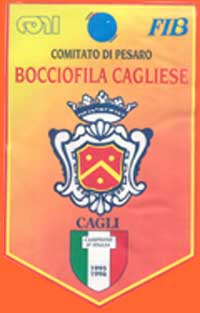
1995-1996 Italian Champions |
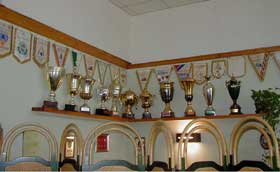  When we were asked to
play, we stepped over the low wooden wall dividing the two fields, onto
their turf—changing from inquisitive journalists to bocce players. When we were asked to
play, we stepped over the low wooden wall dividing the two fields, onto
their turf—changing from inquisitive journalists to bocce players.
 The sight of
this scene is The Silver Caffe and Bocciodromo. The building resembles
a large warehouse. An open room houses a bar and several card tables covered
in green cloth. Trophies and banners line the walls; mementos of Cagli’s
bocce history. A door on the right, flanked by the awards, leads to
the dromo where bocce is played. Noises echo inside, reverberating
off the concrete walls and floors. The only color in the room comes from
the spray painted walls. Five campi, or playing fields, measure four
meters wide and 27 meters long. These extend the length of the building. At the far end of
each campi, metal scoring boards appear along with wooden shelves
to cradle the bocce balls. The sight of
this scene is The Silver Caffe and Bocciodromo. The building resembles
a large warehouse. An open room houses a bar and several card tables covered
in green cloth. Trophies and banners line the walls; mementos of Cagli’s
bocce history. A door on the right, flanked by the awards, leads to
the dromo where bocce is played. Noises echo inside, reverberating
off the concrete walls and floors. The only color in the room comes from
the spray painted walls. Five campi, or playing fields, measure four
meters wide and 27 meters long. These extend the length of the building. At the far end of
each campi, metal scoring boards appear along with wooden shelves
to cradle the bocce balls. |
| Rules of the Game... |
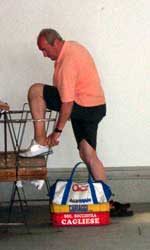  The object
of the game is to try to throw a wooden ball (bocce) as close as
possible to the pallino, the small ball. This may not sound like
the most challenging sport, or an edge-of-your-seat spectator activity for
that matter; however, the Cagliese bocce players prove otherwise.
Gathering almost everyday, a group of regulars enters the Bocciodromo
around 2 p.m. Carrying their worn leather bags, the men change from sneakers
into bocce shoes, flat soled and smooth so their footwear will not
tear up the grainy field. After pulling two balls from their bags, each
man heads to Campo #1 to begin play. The matches are pick up games.
The men divide themselves into one-, two-, or three-person teams depending
on who shows up on any given day. Today it is three against three. The object
of the game is to try to throw a wooden ball (bocce) as close as
possible to the pallino, the small ball. This may not sound like
the most challenging sport, or an edge-of-your-seat spectator activity for
that matter; however, the Cagliese bocce players prove otherwise.
Gathering almost everyday, a group of regulars enters the Bocciodromo
around 2 p.m. Carrying their worn leather bags, the men change from sneakers
into bocce shoes, flat soled and smooth so their footwear will not
tear up the grainy field. After pulling two balls from their bags, each
man heads to Campo #1 to begin play. The matches are pick up games.
The men divide themselves into one-, two-, or three-person teams depending
on who shows up on any given day. Today it is three against three. |

More on Gianni Caselli... |
  One
man tosses the pallino and the game begins. A four-foot wall lines
one side of the campo, where a few of retired men stand, resting
their elbows on the wall, watching the game unfold below them. The men say
little except to declare bianco or azule, the color of the
closest ball. Some men remain stoic, others throw their hands up in agitation
after a poor toss. The group slowly gathers around the pallino and
the cluster of thrown balls anticipating the last ball. We had to be quick
to catch their emotions, which are brief and subtle. Three of the men smile
and three shake their heads as the last ball rolls into place. Now it is
our turn. One
man tosses the pallino and the game begins. A four-foot wall lines
one side of the campo, where a few of retired men stand, resting
their elbows on the wall, watching the game unfold below them. The men say
little except to declare bianco or azule, the color of the
closest ball. Some men remain stoic, others throw their hands up in agitation
after a poor toss. The group slowly gathers around the pallino and
the cluster of thrown balls anticipating the last ball. We had to be quick
to catch their emotions, which are brief and subtle. Three of the men smile
and three shake their heads as the last ball rolls into place. Now it is
our turn.
 Maybe
they asked us to play because they wanted some variety. Maybe they wanted
a good laugh at the two young Americans. I think they wanted to teach us
the game that is their favorite pastime. Their passion. Maybe
they asked us to play because they wanted some variety. Maybe they wanted
a good laugh at the two young Americans. I think they wanted to teach us
the game that is their favorite pastime. Their passion. 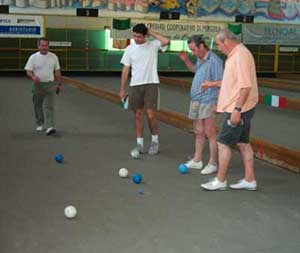
 My partner, Bruno Poeghioui jokingly calls himself, the “Rocky Balboa” of bocce.
He is quick to take my camera and replace it with a heavy wooden bocce
ball. My colleague Bob teams up with the youngest bocce player, former Italian
champ Gionni Caselli. We play a game of two against two with many seasoned veterans
looking on. I try to follow the exact motion Rocky demonstrates for me and
gently roll the ball down the campo. Or so I think. Apparently,
the synthetic, grainy slate-colored material covering the floor does not
produce as much friction as I expected. The ball rolls past the pallino,
many meters beyond an acceptable distance. Rocky, of course, rolls his ball
to within two inches of the pallino.
My partner, Bruno Poeghioui jokingly calls himself, the “Rocky Balboa” of bocce.
He is quick to take my camera and replace it with a heavy wooden bocce
ball. My colleague Bob teams up with the youngest bocce player, former Italian
champ Gionni Caselli. We play a game of two against two with many seasoned veterans
looking on. I try to follow the exact motion Rocky demonstrates for me and
gently roll the ball down the campo. Or so I think. Apparently,
the synthetic, grainy slate-colored material covering the floor does not
produce as much friction as I expected. The ball rolls past the pallino,
many meters beyond an acceptable distance. Rocky, of course, rolls his ball
to within two inches of the pallino. |
|
 Indifferent to the score, “Rocky” is patient, giving simple instructions even I, a
non-conversant in Italian, can understand. With his expertise, he gently guides
me to the best place to stand. By saying either forte or gentile,
he tell me how hard or soft to throw the ball. As my ball flies past the
pallino or stops many yards short, he does not care. It
is more important that I learn how to enjoy the game and the skill and
patience that it requires.
Indifferent to the score, “Rocky” is patient, giving simple instructions even I, a
non-conversant in Italian, can understand. With his expertise, he gently guides
me to the best place to stand. By saying either forte or gentile,
he tell me how hard or soft to throw the ball. As my ball flies past the
pallino or stops many yards short, he does not care. It
is more important that I learn how to enjoy the game and the skill and
patience that it requires.
 Having
some familiarity with an Americanized version of bocce, Bob picks
the game up quickly. Gianni gives him the same broken instructions that
Rocky gave me, only Bob is more accurate at “shooting.” “Shooting” is a
hard airborn toss Having
some familiarity with an Americanized version of bocce, Bob picks
the game up quickly. Gianni gives him the same broken instructions that
Rocky gave me, only Bob is more accurate at “shooting.” “Shooting” is a
hard airborn toss 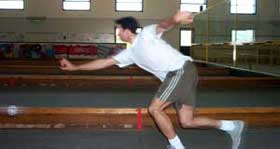 that
knocks an opponent's ball out of the way. It requires a small running start
to build momentum. Bob’s problem is not in the running but in the stopping.
Wearing sandals instead of regulation footwear, he slides madly, losing
his balance. The men howl with laughter. that
knocks an opponent's ball out of the way. It requires a small running start
to build momentum. Bob’s problem is not in the running but in the stopping.
Wearing sandals instead of regulation footwear, he slides madly, losing
his balance. The men howl with laughter.
 We all get beyond the barriers of language and the men
and their students gain respect for one another. Bob and I learn
the great skill involved and the dedication and pride these men take in the sport.
We all get beyond the barriers of language and the men
and their students gain respect for one another. Bob and I learn
the great skill involved and the dedication and pride these men take in the sport.
 When
the game ends in a “tie” the men head into the bar room and settle down
to games of pinochle. They present us each with a small flag commemorating
the Cagliesi Italian Championship of 1995 to thank us. Walking out the doors,
we felt honored by the gift of the experience and by being allowed to be
part of this exclusive group of men. We waved our flags and said ciao
to our new friends. When
the game ends in a “tie” the men head into the bar room and settle down
to games of pinochle. They present us each with a small flag commemorating
the Cagliesi Italian Championship of 1995 to thank us. Walking out the doors,
we felt honored by the gift of the experience and by being allowed to be
part of this exclusive group of men. We waved our flags and said ciao
to our new friends. 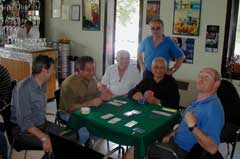
|
 |
Bob Buhowski:
Copy Editing, Photography, Photo Editing, Videography,
Video Editing, Design Production
Lindsay Mead:
Copy, Photography, Videography, Graphics, Graphic Design, Design Production
|  |
| Back
to Cagli
|








 that
knocks an opponent's ball out of the way. It requires a small running start
to build momentum. Bob’s problem is not in the running but in the stopping.
Wearing sandals instead of regulation footwear, he slides madly, losing
his balance. The men howl with laughter.
that
knocks an opponent's ball out of the way. It requires a small running start
to build momentum. Bob’s problem is not in the running but in the stopping.
Wearing sandals instead of regulation footwear, he slides madly, losing
his balance. The men howl with laughter.

